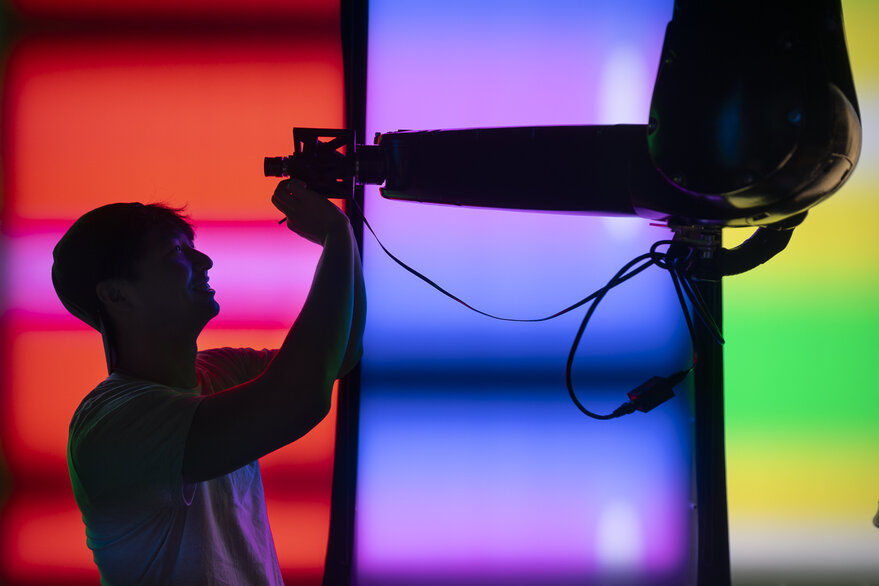PALO ALTO, Calif. – The Center for AEroSpace Autonomy Research (CAESAR) at Stanford University held a kickoff event May 22 to highlight the industry, academia and government collaboration it seeks to foster.
“We founded CAESAR with the objective to tackle and solve the problem of spacecraft autonomy through the judicious incorporation of artificial intelligent components,” said Simone D’Amico, CAESAR co-director and founding director of Stanford’s Space Rendezvous Laboratory. “We want to develop novel algorithms at the intersection of artificial intelligence and guidance, navigation and control.”
In addition, CAESAR researchers are developing a space foundation model, a machine-learning model trained on space data and fine-tuned for space- tasks. The space foundation model “will process diverse input and sensor modalities, both the standard ones like language and video and space-specific ones like lidar, remote-sensing data, space object catalogs,” said Marco Pavone, CAESAR co-director and director of Stanford’s Autonomous Systems Laboratory.
Students at the Center for AEroSpace Autonomy Research at Stanford University. Credit: Andrew Brodhead
Out of Stealth
Although CAESAR was officially launched May 22, the organization has been operating in stealth mode for approximately nine months. During that time, students conducted research projects backed by NASA, SpaceWERX, the National Science Foundation and CAESAR’s founding corporate sponsors Blue Origin and Redwire.
“The outcomes of AI and space operations research will be tremendously valuable to our technology roadmap and advance our products, including space domain awareness capabilities for a range of customers,” Al Tadros, Redwire chief technology officer, said in a statement. “AI-enhanced capabilities could be transformative for in-space servicing, guidance, navigation and control and rendezvous and proximity operations autonomy, and a range of complex mission requirements that Redwire is supporting for current and future missions.”
Early CAESAR projects focused on autonomous rendezvous, proximity operations and docking, as well as rapid characterization of space objects.
In the past, characterizing an unknown space object was a time-consuming and data-intensive task, D’Amico said. CAESAR researchers demonstrated that a convolutional neural network, a type of deep learning algorithm, trained on an extensive array of 3D spacecraft models and imagery can approximate the 3D model of an unknown spacecraft from a single image, he added.
Stanford, NASA, U.S. Space Force, Aerospace Corp. and industry speakers at the CAESAR launch event underscored the potential for AI to streamline space mission planning, enhance space situational awareness and enable spacecraft and rover autonomy.
“AI enabled autonomy can transform the way we do space operations for the Department of Defense and the intelligence community,” said Mike Nemerouf, Aerospace Corp. innovation, science and technology director in the Space Systems Architecture Division. Onboard processors could fuse datasets and downlink information to operators rather than relaying disparate data streams that operators must decipher to make decisions, he added.
Data Scarcity
Speakers also cited the challenge of applying AI to space missions. State-of-the-art AI components are not designed for the harsh space environment. Power on spacecraft tends to be limited. And data needed to train space- AI models often are not available.
CAESAR researchers are addressing some of the challenges by “using the most recent advances in robotics and virtual reality to increase the technology readiness level of new methods and algorithms,” D’Amico said.
The movements of autonomous spacecraft, for instance, are simulated in CAESAR’s robotic testbed. “These testbeds are informed by experience, by lessons learned, by the results that we gain from actual flight missions,” D’Amico said.
D’Amico leads the Starling Formation-Flying Optical Experiment, known as StarFOX, a distributed optical navigation system for satellite swarms.

It’s fascinating to see the collaboration between industry, academia, and government at CAESAR. The research being conducted on spacecraft autonomy is crucial for the future of space exploration.
mexico pharmacies prescription drugs: medication from mexico – mexico drug stores pharmacies
purple pharmacy mexico price list
buy semaglutide online http://rybelsus.tech/# buy semaglutide online
rybelsus generic
https://rybelsus.shop/# semaglutide tablets
ozempic generic: ozempic coupon – ozempic generic
https://ozempic.art/# ozempic generic
rybelsus cost [url=https://rybelsus.shop/#]buy rybelsus online[/url] buy semaglutide online
rybelsus price: semaglutide cost – rybelsus pill
buy ozempic: Ozempic without insurance – buy ozempic pills online
http://ozempic.art/# buy ozempic pills online
buy ozempic ozempic coupon ozempic
ozempic cost: ozempic coupon – buy ozempic pills online
https://ozempic.art/# buy ozempic pills online
ozempic online: buy cheap ozempic – Ozempic without insurance
semaglutide tablets buy semaglutide online semaglutide cost
rybelsus price: cheapest rybelsus pills – rybelsus coupon
ozempic generic: ozempic online – ozempic coupon
buy semaglutide online: rybelsus cost – buy semaglutide pills
https://ozempic.art/# buy ozempic
https://rybelsus.shop/# rybelsus price